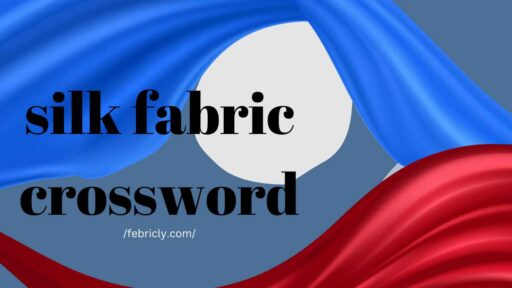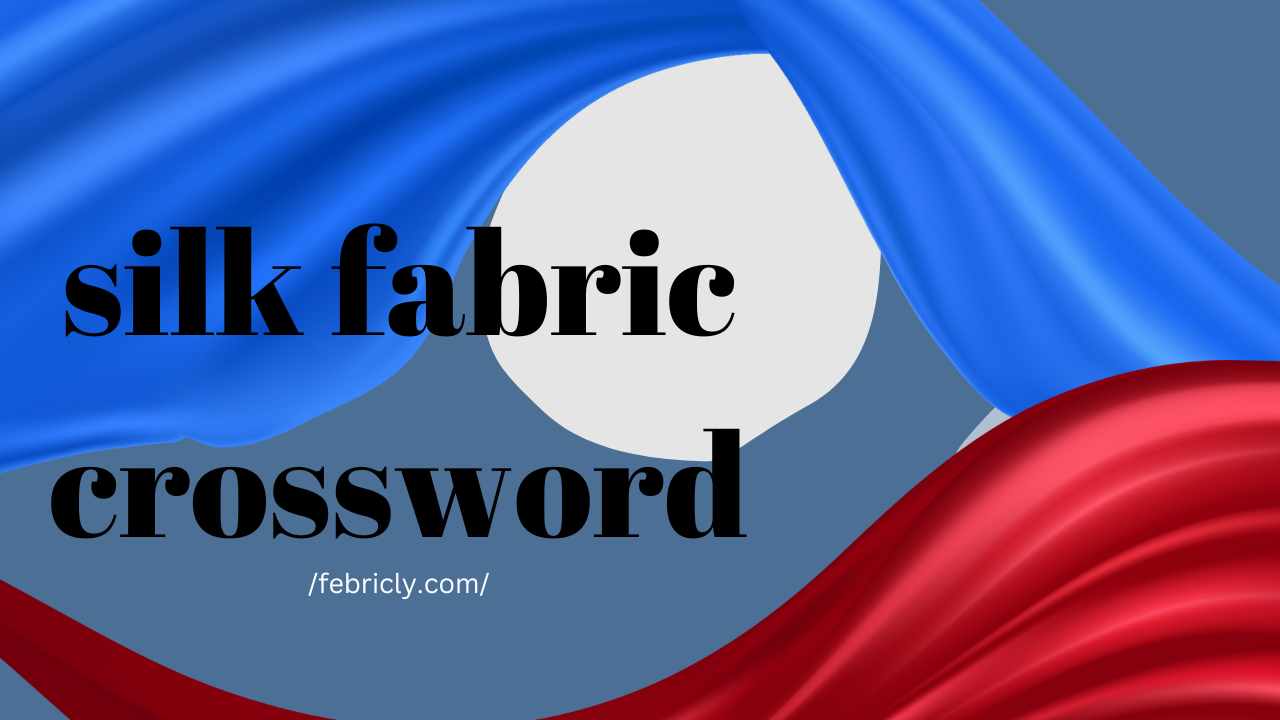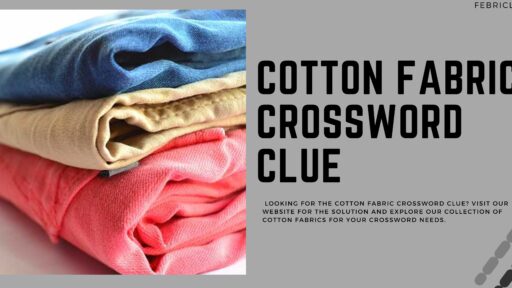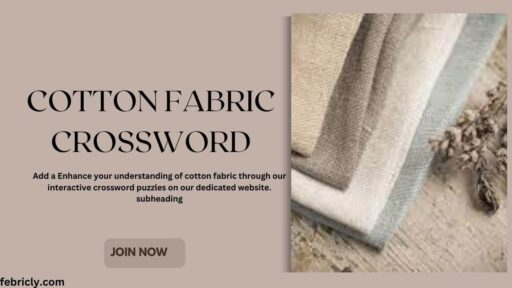Indulge in the captivating world of silk fabric crossword puzzles. Unravel the clues and enhance your knowledge of this exquisite textile. Start solving now!
Silk, a fabric synonymous with luxury and elegance, has captivated the fashion world and crossword puzzle enthusiasts alike. Its rich history, intricate production process, and significant role in sustainable fashion highlight its unique presence in both the sartorial and intellectual realms. This post explores the multifaceted allure of Silk Fabric Guide, from its luxurious appeal in the fashion industry to its intriguing appearance in crossword puzzles.
The History of Silk fabric crossword: From Ancient China to Modern Runways
Silk has a long and fascinating history that dates back over 5,000 years. Legend has it that the discovery of silk was made by the Chinese Empress Si Ling-Chi in 2640 BC when a silkworm cocoon fell into her tea, and she noticed the delicate threads unraveling. The ancient Chinese closely guarded the secret of silk production, and it was highly sought after as a luxury good in trade networks such as the Silk Road. It wasn’t until around 300 BC that silk production spread to other parts of Asia and eventually to Europe.
In ancient China, only members of the royal family were allowed to wear silk garments, making it a symbol of status and wealth. It was also used as a form of currency, with silk being exchanged for other goods and services. Over time, the production of silk became more refined, resulting in different types of silk, such as mulberry silk, which is still regarded as the highest quality.
Today, China remains the largest producer and exporter of silk, accounting for about 60% of global production. However, countries like India and Thailand have also become major producers of silk fabric.
The Production Process: A Delicate Craft
Silk production involves a meticulous process that begins with the cultivation of silkworms. These tiny creatures feed on mulberry leaves and produce a protein-based fiber to make their cocoons. Farmers carefully monitor the growth and development of the silkworms before harvesting the cocoons.
Once harvested, the cocoons are boiled in water to loosen the silk threads and then carefully unraveled. These fine threads are spun together to create silk yarn, which is then woven into fabric. The entire process requires skill and precision, making it a labor-intensive craft that has been passed down for generations.
The Cultural Tapestry of Silk
Silk’s story begins in ancient China, where it was discovered over 5,000 years ago. Revered for its luster and softness, silk quickly became a highly prized commodity, integral to the cultural and economic exchanges along the Silk Road. This history adds a layer of enigma and sophistication to silk fabric, making it a captivating subject for crossword puzzles, often evoking clues related to its rich past and exotic allure.
The Journey of Silk Fabric Production and Sustainability
The production of silk fabric is a testament to human ingenuity and nature’s marvels. Silk cultivation involves a meticulous process, beginning with the breeding of silkworms on mulberry leaves. After spinning their cocoons, the silk fibers are carefully extracted, spun, woven, and finished into the fabric we admire.
Sustainability Challenges and Innovations
While traditional silk production poses environmental and ethical challenges, significant strides toward sustainability are reshaping the industry. Innovations such as peace silk, which allows the moth to emerge from the cocoon before fabric production, and lab-grown silk, as seen in Stella McCartney’s pioneering collaboration with Bolt Threads, spotlight the industry’s efforts to balance luxury with eco-conscious practices.
Case Studies in Sustainable Silk Fashion
- Gina Tricot and its sustainable silk garments initiative demonstrate how the industry can minimize waste and use eco-friendly production processes.
- Eileen Fisher‘s use of peace silk underscores the brand’s commitment to ethical fashion.
- The Stella McCartney collaboration with Bolt Threads on lab-grown silk material showcases cutting-edge sustainability.
- Green Fashion Week in Italy, where designers spotlight organic and sustainable silk, illustrates the fabric’s role in eco-conscious fashion movements.
Silk in Luxury Fashion
Luxury brands have long cherished silk for its versatility and opulence. From Hermès’ iconic scarves to Versace’s sumptuous gowns, silk fabric plays a pivotal role in defining high-end fashion. These examples not only underscore silk’s enduring appeal but also its ability to reinvent itself in harmony with contemporary designs and sustainable initiatives.
Solving the Puzzle of Silk in Crosswords
Crossword puzzles often feature silk as a clue, drawing on its historical and cultural significance or its characteristics as a luxury fabric. The intricate process of silk production, its role in sustainable fashion, and its ubiquity in luxury brands provide rich fodder for puzzle enthusiasts keen on weaving the threads of knowledge into their problem-solving strategies.
Common Clues and Answers
- Clue: “Fabric of luxury” | Answer: Silk
- Clue: “Sustainable fashion choice” | Answer: PeaceSilk
- Clue: “Ancient trade route commodity” | Answer: Silk
Your Guide to Purchasing Quality Silk Fabric
For those looking to incorporate silk into personal projects, understanding quality is key. Look for indicators such as the fabric’s weight (measured in mommes), sheen, and hand feel. Sustainable certifications can also guide eco-conscious decisions, helping you choose a fabric that aligns with both your aesthetic and environmental values.
Wrapping It Up: Silk’s Enduring Appeal
Silk fabric bridges the worlds
Connecting centuries-old traditions with modern luxury and sustainable innovation. Its presence in both fashion closets and crossword puzzles stands as a testament to its timeless appeal and multifaceted nature.
We invite you to share your insights on silk fabric, its impact on sustainable fashion, or your experiences solving silk-related crossword puzzles. How do you perceive silk’s role in today’s environmentally aware fashion landscape? Join the conversation and enrich our understanding of this exquisite material’s place in our lives and puzzles.

Silk as a Symbol of Sophistication and Status
Throughout history, silk has been synonymous with luxury, wealth, and status. In ancient China, only the emperor and his family were allowed to wear clothing made from silk fabric. This exclusivity further enhanced its desirability and cemented its place in high-end fashion.
Even in modern times, owning a silk garment or item is seen as a symbol of sophistication and refined taste. Its softness, sheen, and draping properties make it an ideal fabric for elegant evening gowns, formalwear, and delicate lingerie.
The Crossword Puzzle Connection
In crossword puzzles, clues related to silk often allude to its luxurious nature and history. Other times, they may reference its production process or sustainability initiatives, showcasing the fabric’s evolving role in our society.
Overall, solving silk-related crossword clues not only tests our knowledge but also allows us to appreciate the cultural significance and allure of this ancient fabric.
The Enduring Allure of Silk
From its mystical beginnings in ancient China to its current place in sustainable fashion and crossword puzzles, silk continues to captivate and inspire us. Its enduring appeal serves as a reminder of the beauty and ingenuity that can emerge from human creativity, cultural exchanges, and nature’s gifts. So next time you see silk mentioned in a crossword clue or on a fashion runway, take a moment to appreciate its rich history and multifaceted role in our world today.
And remember, there is always more to learn and discover about this marvel of nature. So keep exploring, keep creating, and keep admiring the wonders of silk. Only then can we truly grasp its true value and significance in our lives. Happy puzzling!
A Future Woven with Innovation and Tradition
The future of silk is as bright and promising as its past. With ongoing advancements in biotechnology and sustainable farming practices, we are starting to see silk in a new light. Innovators and designers are pushing the boundaries of what silk can do, from integrating it into wearable technology to finding new ways to recycle and reuse silk materials. This forward-thinking approach ensures that silk remains relevant and cherished in both the fashion industry and beyond.
At the same time, the reverence for traditional silk-making methods continues to thrive, preserving the cultural heritage and artisan skills that have been passed down through generations. This blend of innovation with tradition offers a fascinating glimpse into the future of textiles, where sustainability, technology, and history intertwine.
The dual path of innovation and tradition promises to keep silk at the forefront of luxury and eco-conscious fashion for years to come. By continuing to explore and innovate while respecting and preserving traditional techniques, the silk industry is set to weave a future that honors its rich past while boldly stepping into new territories.
The Role of Silk in Cultural Celebrations
Silk’s significance extends beyond the domains of fashion and innovation, playing a pivotal role in cultural celebrations around the globe. In many cultures, silk garments and textiles are integral to ceremonies and festivities, symbolizing purity, joy, and status. For instance, in Indian weddings, silk sarees adorned with gold and intricate designs are considered auspicious and a marker of luxury. Similarly, in China, silk fabrics are used in traditional dresses for Lunar New Year celebrations, representing good fortune and happiness.
This deep-rooted cultural significance of silk adds another layer to our appreciation of this versatile material. It’s not just about the texture, the sheen, or the durability of silk, but also about the stories, traditions, and emotions it embodies. By participating in these cultural practices, we not only keep the tradition alive but also contribute to the global tapestry of heritage and identity that silk weaves together.
FAQs on Silk Fabric
How do I identify genuine silk fabric?
Genuine silk can be identified by its unique sheen, with colors that shift when viewed from different angles. The burn test, while destructive, also tells us that real silk will smell like burnt hair and leave fine, soft ash.
What is the best way to care for silk garments?
To maintain the integrity and beauty of silk, it’s recommended to hand wash or use a gentle, cold cycle on your washing machine, avoiding strong detergents. Always check the care label for specific instructions.
Can silk be an ethical and sustainable choice?
Yes, silk can be sourced ethically and sustainably through organic farming methods and by ensuring fair trade practices. Look for certifications like Global Organic Textile Standard (GOTS) to ensure you’re making a responsible choice.
Why is silk considered a luxury fabric?
Silk’s status as a luxury fabric is due to its complex production process, exquisite feel, and durability. It’s a natural protein fiber, with each strand being finer than a human hair yet strong as steel in tensile strength.
Is silk fabric suitable for all seasons?
Yes, silk is highly adaptable; it can keep you cool during the summer and warm in the winter. It’s a natural fabric that breathes, helping to regulate body temperature regardless of the season.
Conclusion of Silk Fabric Crossword
From ancient legends to modern fashion, silk has woven its way into our hearts and lives, serving as a symbol of luxury, beauty, and innovation. Its enduring allure and versatility make it a timeless fabric that continues to inspire and captivate us. So whether you’re solving crossword puzzles or choosing your next outfit, take a moment to appreciate the wonder and magic of silk.





